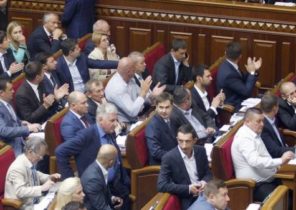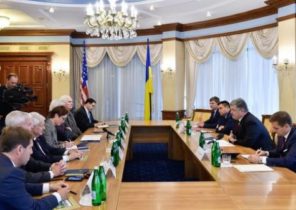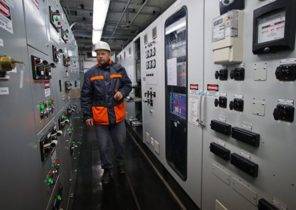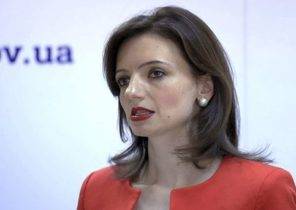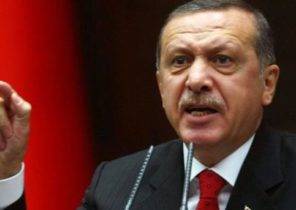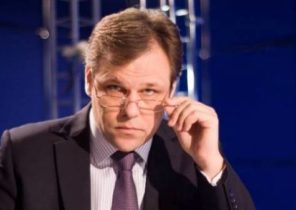The evening of June 2 when I was 38 years old, my eyes froze on the news that appeared in the Twitter feed: “the President of Russia Vladimir Putin signed a document entitled “principles of state policy in the field of nuclear deterrence””.
It is known that earlier such documents approved in 2010 — “the foundations of the policy of nuclear deterrence” and “Military doctrine”. This means that nuclear strategy adjustments made after about ten years.
Moreover, I was surprised that disclosed the full text. In 2010, nothing except the name, has not been published. For this reason, Russia’s nuclear policy caused various conjectures.
Since this time became known to the whole text, it is quite natural that international military experts in Russia, including me, drew attention to its contents. Due to an unexpected gift on birthday that evening I had to commit to transfer nuclear doctrine of Russia.
So, what is written in the document, is shrouded in mystery? Will present the main content.
Now the main goal — a nuclear weapon?
The basis of the policy of nuclear deterrence consists of the following four items:
1. General provisions;
2. The essence of nuclear deterrence;
3. The conditions of transition of Russia to use nuclear weapons;
4. Tasks and functions of the Federal bodies of state power, other state bodies and organizations on the implementation of the state policy on nuclear deterrence.
In the first paragraph, as the name implies, contains General ideas about nuclear deterrence, however, the interest in this is the fifth article: “the Russian Federation considers nuclear weapons solely as a deterrent, the use of which is extreme and necessary measure, and shall make all necessary efforts to reduce nuclear threats and prevent aggravation of interstate relations that could spark a military conflict, including nuclear.”
The main purpose of nuclear weapons is to stop (restrain) the attack of the enemy. The idea to use nuclear weapons before the enemy appeared in 2010 years with the administration of us President Barack Obama and has caused both positive and negative assessments.
The United States has always adhered to the tactics, which did not exclude the possibility of pre-emptive strike if necessary. In the end, the Obama administration was also forced to abandon the idea of no pre-emptive strike to better times (the new nuclear strategy outlined by the administration of President Donald trump, clearly denies this principle).
Meanwhile, in the published Russian policy of nuclear deterrence is simply stated: “solely as a means of deterrence.” Is Russia adopted the doctrine, which would cause a doubt even from the Obama administration?
A preemptive strike is not excluded
Of course, this can not be.
The Soviet Union, which prided overwhelming advantage over the West in conventional arms, followed the policy of not using nuclear weapons before the enemy, but in today’s Russia, things are not so.
Despite impressive development in comparison with the time of the post-Soviet chaos, the Russian conventional weapons do not go neither in quantitative nor in a qualitative comparison with the us. And in the far East of Russia is waiting for China, one of the world leaders in conventional arms.
For this reason, in the first military doctrine, adopted after the collapse of the USSR in 1993, had abandoned the policy of no pre-emptive nuclear strike.
In 2000 it was spelled out that in the event of threats to national security, even if the enemy attacks using conventional weapons, Russia will use nuclear missiles. In versions 2010 and 2014 (current) texts of virtually identical, except for some nuances.
In other words, Russia has the right to use nuclear weapons in two cases: (1) if against Russia or its ally use nuclear or other weapons of mass destruction, (2) if conventional weapons, the enemy threatens the very existence of Russia.
The wording is slightly different: in 2000, a prerequisite for using nuclear missiles were “state security”, and in 2010 and 2014, “the existence of the state”, but the essence does not change.
At the level of official statements, Russia also not excluded the possibility of a preemptive strike, so it is obvious that the phrase “…which is an extreme and necessary measure…” means other cases in addition to nuclear attacks.
Incidentally, the expression “a threat to the very existence of the state” is the new “fundamentals of the policy of nuclear deterrence.”
Pre-emptive strike and in danger of loss of the territories
So what exactly does the phrase “a threat to the very existence of the state”?
First, there is no doubt that Russia will use nuclear weapons if, for example, NATO tanks will be closer to Moscow.
In such a situation can be used strategic nuclear weapons (Intercontinental ballistic and other missiles of distant radius of action, which reach the United States). After the cold war, Russia also held military strategy, in which believed that you can avoid starting full-scale nuclear war, if on the battlefield to apply small-scale (tactical) nuclear weapons.
The so-called “theory of limited nuclear war” (or “regional nuclear deterrence” in Russian), in accordance with which nuclear weapons are used in combat, ensuring victory.
In “principles of policy of nuclear deterrence” also States: “Nuclear deterrence is a continuous process in peacetime, during the immediate threat of aggression and wartime, until the beginning of the use of nuclear weapons”. It is supposed that nuclear deterrence continues to function after the violence began.
But what steps will be taken, if the case is not so extreme?
For example, the war began, and soon it became obvious to everyone the lack of strength of the Russian troops? Or the situation is close to war, in which Russia has little chance to win?
In previous military doctrines such cases was not spelled out.
Meanwhile, in the recently published document says the purpose of nuclear deterrence: “the State policy of nuclear deterrence is defensive in nature, aimed at maintaining the capability of nuclear forces at a level sufficient to ensure nuclear deterrence, and guarantees the protection of the sovereignty and territorial integrity of the state, deterring a potential enemy from aggression against the Russian Federation and (or) its allies, and in the case of a military conflict is to prevent the escalation of hostilities and their termination on terms acceptable to the Russian Federation and (or) its allies of conditions.”
This means that even when there is no immediate threat to the existence of the state the possibility of loss of the territories subject to the postulates “…which is an extreme and necessary measure…” and “a threat to the very existence of the state”.
Suspicions to use nuclear weapons to prevent escalation
Even more interesting is the final part of this paragraph: “…in the case of a military conflict is to prevent the escalation of hostilities and their termination on terms acceptable to the Russian Federation and (or) its allies of conditions.”
The use of nuclear missiles to prevent the escalation or the so-called “deterrence of escalation” and “escalation for the sake of deterrence of escalation” — these ideas attracted the attention of Western military experts last ten years.
For example, as it was during the Ukrainian crisis 2014: Russia has used military force against neighbouring countries, and if NATO tried to stop it with military action (in other words, in the case of expansion of escalation), the Russian army inflicted would pinpoint nuclear strike (to suppress the power, causing nuclear strike on sites where no or few people) that would scare NATO, and she wouldn’t interfere.
We can say differently- there are suspicions that in case of war with NATO Russia will analyze the possibility of use of nuclear weapons, not after the fact, and even before the conflict began.
Perhaps there is a “hidden doctrine”
Such suspicions NATO deepened in connection with the “policy of nuclear deterrence”, which became known in 2010, but which was not published.
As I have already noted, the military doctrine of 2010 does not provide the use of nuclear weapons to prevent escalation.
However, answering a question “News” in 2009, Secretary of the Russian security Council Nikolai Patrushev said: “We expect the use of nuclear weapons in regional conflicts and local wars. We do not deny the possibility of a preventive nuclear strike against the aggressor in terms of the threat to the security of the country.”
We can assume that the “hidden doctrine” was part of the “foundations of nuclear deterrence policy,” 2010.
By the way, it is known that the Russian defense circles nuclear strategy of “deterrence of escalation” had been discussed since the 1990-ies. I have no doubt that the Russian army were discussing the use of nuclear power in this form.
The configuration overview of the nuclear forces, adopted by the administration of the trump in 2018, this issue was the main topic. The course was set for equipping ballistic missiles of submarines “Trident” low-yield nuclear warheads to inflict a balanced retaliation in the case of a point of application of Russian nuclear forces.
This so-called low-yield Trident (LYT), which were produced in 2019 and in February of this year adopted.
The deliberate mixing of “strategy of containment” with the “strategy of nuclear applications”
Let us return to the “fundamentals of the policy of nuclear deterrence” for 2020. As we noted in the first paragraph there are words on the avoidance of escalation.
This means that Western suspicions were not unfounded — Russia had nuclear strategy in the form of escalation.
But the strange thing is that in the third paragraph, “Conditions of transition of Russian Federation to the use of nuclear weapons”, says nothing about this. According to some sources, Russia uses nuclear power in the following cases:
(1) When there is reliable information on the ballistic missile attack on Russia or its ally;
(2) When the enemy has used against Russia or its ally with nuclear or other weapons of mass destruction;
(3) When the enemy invades in the important Russian government or military facilities, disruption of which prevents the nuclear second strike;
(4) If an attack on Russia with conventional weapons threatens its existence.
Paragraphs (2) and (4) included in the earlier military doctrine.
(1) is the start according early warning strike back when a message arrives on launch nuclear missiles at Russia. (3) is a new doctrine about the response in the case of cyberware nuclear facilities in Russia. On the “deterrence of escalation” does not say anything.
One of the interpretations of “deterrence of escalation” — a strategy of intimidation of a potential enemy in order to contain it. It might not involve real use of nuclear power.
The point being that Russia will arrange, if NATO is to assume that she will respond with a nuclear missile in any military action against her, but really she’s not going to make a preemptive strike.
However, if you say this on the record, the credibility of the deterrence is not, so maybe in the first Chapter and added the phrase “preventing escalation”.
According to the Director of the Russia and Eurasia program Center for strategic and international studies (CSIS) Olga Oliker (Olga Oliker), such uncertainty is of a strategic nature — deliberately mixes the strategy of containment and the strategy of use of nuclear weapons.
Official policy is only half the truth
However, based on the foregoing, it is premature to claim that Russia has no strategy of “escalation”. As American overview of the configuration of nuclear forces, “Basic policy of nuclear deterrence” are not a strategy.
The working strategy is a top-secret document, the contents of which are usually not disclosed. It identifies specific objectives and a list of resources to strike at him.
In the case of the US, there are documents such as pre-existing “common operational plan for a nuclear strike” or current “Operational plan”. Known only by their names and the period of amendments, however, Russia has never disclosed this information and is unlikely to ever do it.
In the 15th article of the second Chapter “fundamentals of the policy of nuclear deterrence” States: “the Uncertainty for a potential enemy of the scale, time and place of the possible use of forces and means of nuclear deterrence.”
On this basis it is obvious that Russia is not going to publish the full content of nuclear strategy.
Russia expert Michael Kofman, an expert Corporation, “Center for naval analysis,” says the Russian working strategy in the usual ironic way — it is defined in a room without Windows. The official policy (“the policy Framework of nuclear deterrence” or overview of the configuration of the nuclear forces) is only half the truth, expressed in General terms.
The strategic importance of official statements
The current “policy Framework of nuclear deterrence” suggests that Russia is gradually moving to the aggressive nuclear strategy.
Meanwhile, due to the fact that the unknown texts of the previous documents, it is difficult to judge how has changed the version 2020 compared to previous doctrines.
Moreover, its content is not much different from what was discussed by Russian military experts informed, and “preventing escalation” never went beyond threats.
In this regard, I believe that by publishing a nuclear doctrine, Russia had two purposes. First, this year Russia plans to update “the national security Strategy of the Russian Federation”, the core document for planning of development of system of ensuring national security, and in this connection it will also be a revised military doctrine, which represent the guidelines in the military sphere.
I think standards for the use of nuclear forces in the new military doctrine will be slightly different from the version 2014. The aim was not to arouse suspicion of the existence of a “hidden doctrine”.
It is worth noting, and I already said that the existence of such “hidden doctrine” is undeniable.
This goal leads us to the second. In 2019 the Contract was canceled on the elimination of intermediate-range and shorter-range, and in the near future to expire on the start-3. In this regard, Russia is forced to revise the terms of nuclear deterrence.
Perhaps Russia wanted to exert pressure on the West, therefore, noted that the nuclear Arsenal could be used in response to the doctrine of the trigger, according to long-range detection and cyber attacks, which did not contain the previous military doctrine, and released a nuclear strategy, which does not deny the possibility of “escalation”.
That is, apparently, the strategic intent of Russia was to strike at the same time as transparency and uncertainty.
